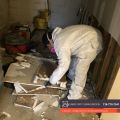Different Types of Mold Testing Techniques Explained

Mold testing is a critical step in identifying and addressing mold issues in indoor environments. There are several mold testing techniques available, each with its advantages and applications. Understanding the different types of mold testing techniques can help homeowners and property owners make informed decisions about mold assessment and remediation. In this article, we will explain some of the most common mold testing techniques used by professionals.
Air Testing/Sampling:
Air sampling is one of the most common and widely used mold testing techniques. It involves collecting air samples from the indoor environment to analyze the concentration and types of mold spores present. There are two primary methods of air sampling:
Spore Trap Air Sampling: Spore trap air sampling uses a pump to draw air through a sampling cassette or filter. The cassette collects mold spores present in the air. The collected samples are then sent to a laboratory for analysis. This method provides valuable information about the types and concentrations of mold spores in the air.
Bioaerosol Impaction: Bioaerosol impaction involves using a bioaerosol sampler to impact air onto a nutrient-rich agar surface. This method collects both viable and non-viable particles, including mold spores. The samples are then analyzed in a laboratory to determine the concentration of mold spores and other particles in the air.
Surface Sampling:
Surface sampling involves collecting samples from visible mold growth or suspected areas of mold contamination on surfaces. There are several methods of surface sampling:
Swab Sampling: Swab sampling uses a sterile swab to collect mold samples from surfaces. It is commonly used for testing small areas or specific materials. Swab samples are then sent to a laboratory for analysis to identify the mold species.
Tape Lift Sampling: Tape lift sampling involves using clear tape to collect mold spores from surfaces. The tape is then analyzed under a microscope to identify the mold species. This method is useful for testing large areas or materials with visible mold growth.
Bulk Sampling:
Bulk sampling involves collecting physical samples of materials suspected to be contaminated with mold. The collected samples are then sent to a laboratory for analysis to identify the mold species and assess the extent of contamination. Bulk sampling is commonly used when the presence of mold is suspected but not visible.
Dust Sampling:
Dust sampling is used to assess the amount of settled dust and the presence of mold spores within the dust. Dust samples are collected using specialized dust collectors or cassettes. The collected samples are sent to a laboratory for analysis to determine the types and concentrations of mold spores present.
ERMI (Environmental Relative Moldiness Index) Testing:
ERMI testing is a comprehensive DNA-based mold testing method that identifies and quantifies mold species in dust samples. It measures the moldiness of a building by comparing the types and quantities of mold present to a national database. ERMI testing provides an overall assessment of mold contamination and is useful for identifying potential health risks associated with specific mold species.
VOC (Volatile Organic Compounds) Testing:
VOC testing is a mold testing technique that measures the volatile organic compounds emitted by mold. Mold produces various VOCs during its growth and metabolic processes. VOC testing can detect hidden mold growth and assess the overall air quality in a building.
Conclusion:
Different types of mold testing techniques provide valuable insights into the presence and extent of mold issues in indoor environments. Air sampling, surface sampling, bulk sampling, dust sampling, ERMI testing, and VOC testing are some of the common mold testing methods used by professionals. Each technique has its advantages and applications, and the choice of testing method depends on the specific situation and goals of the mold assessment. If you suspect mold growth in your home or property or require mold inspection and testing for post-remediation verification, it is essential to engage certified mold professionals like Bay Area Mold Pros. Their expertise in mold testing can help accurately assess mold-related issues and ensure a safe and healthy indoor environment.
Bayareamoldpros is a leading mold inspection and mold testing company providing quality mold analysis services and helping families & businesses overcome the devastating setbacks caused by mold. Bay Area Mold Pros suggests every homeowner in the San Francisco area should get periodic mold inspections. To schedule our mold inspection & mold testing services visit our website bayareamoldpros.com either email us or fill in the contact form on our website. We can be reached 24/7 at (650)762-6228.







